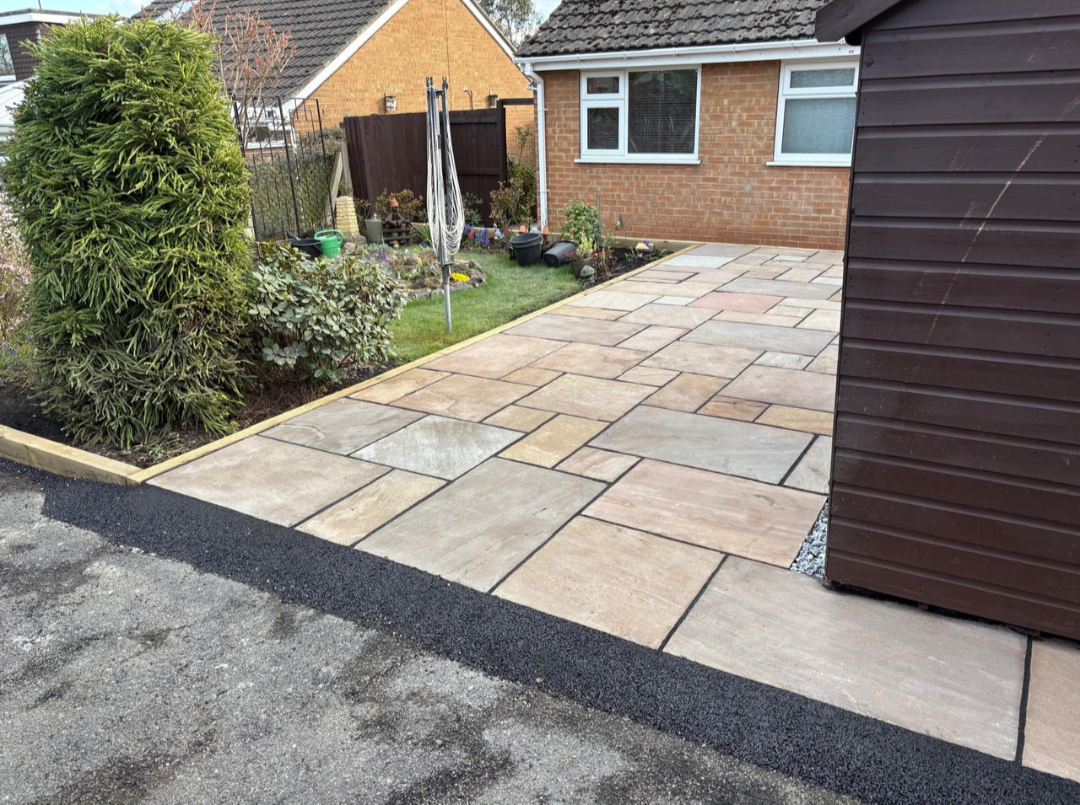Garden paving isn’t just something you walk on - it’s a design decision that shapes how your outdoor space looks, feels, and functions.
Whether you're framing a patio, defining pathways, or adding structure to your garden, the materials and layout you choose play a key role in the overall aesthetic and usability of your space. From boosting kerb appeal to creating zones for relaxation or entertaining, paving can elevate your garden in ways that go far beyond practicality.
In this guide, we'll break down everything you need to know about garden paving, from choosing the right materials to keeping them looking great for years to come.
1. Choosing Paving Materials
The foundation of any good paving job is the choice of material. Common options include concrete, porcelain, natural limestone, natural sandstone and natural granite, each with its different advantages.
Here's a closer look at these materials to help you decide which might work best for your garden:

Concrete
Concrete is best for budget-conscious gardeners seeking a versatile and low-maintenance paving solution.
- Cost-Effective and Versatile: Concrete is one of the most budget-friendly options on the market, making it ideal for large-scale projects or those on a tighter budget.
- Endless Customisation: Available in various colours, textures, and finishes, concrete can mimic the look of natural stone or offer a sleek, modern aesthetic.
- Durability: While not as long-lasting as some natural stones, a well-laid and well-maintained concrete surface can still provide years of reliable use.
- Low Maintenance: It's easy to clean and repair, making it a practical choice for busy gardeners.

Natural Sandstone
Sandstone is best for adding warmth and character to traditional or rustic garden designs.
- Rustic and Warm Aesthetic: Sandstone has a natural, earthy charm, often featuring warm tones like golden browns, soft creams, and rich reds. Its colour palette makes it a great fit for traditional or rustic-style gardens, adding warmth and character to outdoor spaces.
- Texture and Variation: Its slight riven texture and subtle variations in colour add character and uniqueness to each stone. Sandstone is often available in a range of colourways, from soft creams and greys to rich reds and browns, giving you plenty of flexibility to match your garden’s style.
- Durability: While slightly softer than granite, sandstone is still tough enough to handle foot traffic and weather exposure.
- Affordable for Natural Stone: Among natural stone options, sandstone tends to be more budget-friendly while still delivering an elegant appearance.

Porcelain
Porcelain is best for modern garden designs where elegance, durability, and low maintenance are priorities.
- Elegant and Modern: Porcelain paving has a high-end feel due to its clean lines and consistent colours, making it perfect for contemporary spaces.
- Low Porosity: Porcelain is non-porous, which means it resists water absorption, making it an excellent choice for areas with heavy rainfall.
- Durable and Stain-Resistant: Porcelain is highly durable, scratch-resistant, and easy to clean, staying beautiful with minimal effort.
- Wide Range of Styles: It comes in a variety of finishes, from smooth and polished to textured designs that resemble wood or stone.

Natural Limestone
Limestone is best for creating a refined, timeless outdoor space with a soft, elegant appearance.
- Soft and Sophisticated Look: Limestone has a chic, understated appearance, often with muted tones like beige, ivory, and grey, giving your garden a timeless feel.
- Smooth Texture: Its naturally smooth surface gives it a refined finish, perfect for patios or dining areas.
- Easy to Work With: Limestone is relatively easy to cut and shape, allowing for creative patterns and layouts.
- Durability: While it requires occasional sealing to maintain its look, limestone can stand up to everyday wear and tear with ease.

Natural Granite
Granite is best for high-traffic areas or modern gardens where durability and a sleek finish are key.
- Highly Durable: Granite is one of the toughest and most durable materials available, making it ideal for heavy-use areas or driveways.
- Modern, Sleek Finish: Its natural sparkle and smooth, polished surface exude luxury, making granite a popular choice for contemporary gardens.
- Weather-Resistant: Granite's low porosity and high density make it resistant to water, stains, and even frost, making it perfect for outdoor use in all climates.
- Wide Colour Range: From deep blacks to light greys and even speckled patterns, granite offers plenty of choice for customisation.
2. Paving Design Considerations
Footfall and Function
One of the most important things to think about is how much foot traffic the area will get. High-traffic zones like paths, patios, or driveways need durable materials that can handle wear and tear over time. In quieter corners of the garden, you might prioritise aesthetics and texture over toughness, giving you more flexibility with your choices.
Paving Layout Patterns
The way your paving stones are laid out can have a big impact on the overall look and feel of your garden. Layout patterns aren’t just decorative - they can influence how spacious, formal, or relaxed a space feels.
Some popular options include:
- Stretcher Bond: Simple and clean, this pattern uses rows of stones offset from each other, ideal for modern or minimalist designs.
- Herringbone: A classic zigzag pattern that’s both visually striking and highly durable, perfect for driveways or high-traffic areas.
- Basket Weave: A traditional pattern that adds charm and texture, often used in cottage-style gardens.
- Random or Mixed Sizes: Great for a more natural, organic look, especially when using sandstone or limestone.
Colour and Texture Choices
The colour and texture of your paving can dramatically influence the mood and style of your garden. Lighter tones like cream or grey can make small spaces feel larger and brighter, while darker shades add depth and contrast. Textured or riven finishes like sandstone offer grip and a more natural look, while smoother surfaces lend a sleek, modern feel.
Think about how your paving will interact with other elements in your garden, such as planting, furniture, and lighting. A well-chosen colour and texture can tie everything together beautifully.

3. Preparing for Installation
Proper installation begins with solid foundations, including thorough ground preparation and effective drainage systems. These measures prevent issues like water accumulation, shifting, or damage to the paving over time.
This stage is where experience really counts. While some keen DIYers might be tempted to tackle this stage themselves, it’s worth bringing in professionals who understand the complex nuances of levelling, sub-base installation, and drainage solutions.
At Ascot Fencing, we handle and ensure that all tasks like levelling, sub-base installation, and drainage solutions are completed to the highest standard, tailored to your specific needs. We also provide guidance on materials and design, ensuring durability and aesthetics work seamlessly together.
By relying on professional expertise, you can trust that your paving will not only look great but remain structurally sound for years to come.
4. Installation Process
Once the design and materials are finalised, it’s time to bring your paving plans to life. A successful installation relies on careful preparation and attention to detail at every stage.
Here’s what typically goes into the process:
- Site Clearing: The area is thoroughly cleared of existing materials and debris to prepare for installation.
- Base Layer: A well-calculated base layer is laid to ensure a strong, stable foundation for the paving stones.
- Stone Placement: Paving stones are placed meticulously following the design plan for accuracy and alignment.
- Joint Filling: Joints between the stones are filled to secure them and prevent weed growth, ensuring structural integrity.
- Safety Standards: Professionals maintain high safety standards throughout the process to protect both the team and your property.
By hiring experts like Ascot Fencing, you ensure precision and care at every step of the process.

5. Maintenance and Upkeep
Proper maintenance is key to preserving the appearance and durability of your paved surfaces. Regular cleaning, such as sweeping or power washing, helps prevent dirt, stains, and debris buildup, keeping your paving fresh and appealing. Areas prone to moss or weed growth may benefit from periodic treatments to protect the joints.
Applying a sealant periodically can further safeguard your paving, protecting it from moisture damage, weathering, and staining while extending its lifespan.
Prompt repairs are crucial to prevent minor issues like cracks or loose stones from escalating into larger problems. Addressing these quickly, such as filling cracks or re-setting displaced stones, ensures structural integrity and avoids costly fixes down the line.
Get Paving Help From Ascot Fencing
Effective garden paving requires thoughtful planning, balancing aesthetics and practicality. To ensure the best results, consulting professionals like Ascot Fencing can make all the difference.
With extensive expertise, we offer tailored paving solutions to suit your needs - helping with material selection, precise installation, and long-term maintenance.
What we pave:
- Driveways: Durable and stylish driveways that withstand vehicle wear and boost curb appeal.
- Patios: Custom patios for dining, relaxing, or entertaining, designed to suit your style and needs.
- Pathways: Attractive, functional pathways that complement your garden’s design.
- Courtyards: Versatile courtyards tailored for relaxation or entertaining.
Our commitment to quality ensures a durable, visually appealing finish that enhances your outdoor space for years to come.
Got somewhere you want paving? Get in touch with Ascot Fencing now for a free quote.




